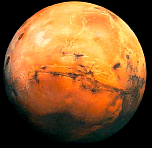|
Mars
 Mars is commonly known as the red planet, and probably got its
name because of this, as Mars is the god of war. Mars is the fourth
furthest planet from the Sun and the seventh largest. It has quite a
varied terrain. One of the most interesting features of this terrain
are the two permanent polar caps of solid carbon dioxide (dry ice).
Mars is known to have very high winds and can also have dust storms
that last for several months.
Mars is commonly known as the red planet, and probably got its
name because of this, as Mars is the god of war. Mars is the fourth
furthest planet from the Sun and the seventh largest. It has quite a
varied terrain. One of the most interesting features of this terrain
are the two permanent polar caps of solid carbon dioxide (dry ice).
Mars is known to have very high winds and can also have dust storms
that last for several months.
One day and/or year on Mars is very similar to one on Earth, but its
high temperatures and make up of its atmosphere mean that it cannot
sustain life. Mars has two small moons, which are relatively close to
its surface, called Phobos and Deimos. Phobos is the larger
of the two moons, and because it is so close to the surface of Mars
(just 6000km away) it orbits Mars twice each day. Deimos is the smallest
known Moon in the Solar System, and is only 12km in diameter.
|
Diameter
|
6, 800 km
|
|
Mass
|
6.42 × 1023kg
|
|
Mean Distance from sun
|
227.94 × 106 km
|
|
Mean Density
|
3.95 g/cm3
|
|
Rotational Period
|
1.02 Earth days
|
|
Orbital Period
|
687 Earth days
|
|
Mean Orbital Velocity
|
24 km/s
|
|
Atmosphere
|
95% carbon dioxide, 3% nitrogen, 2% argon
|
|
Average Surface Temperature
|
- 50°C
|
|
Equatorial Surface Gravity
|
3.72 m/s2
|
|